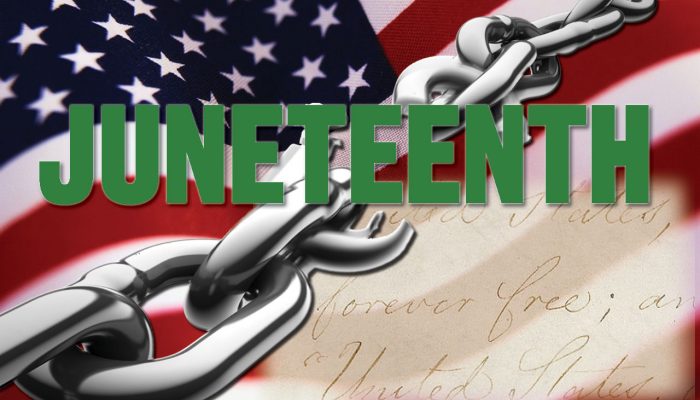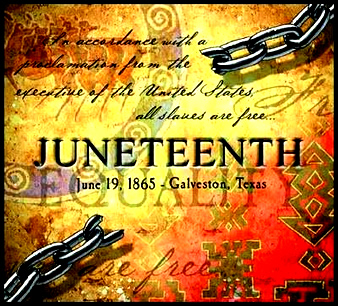
“Juneteenth” is the contracted version of “June 19th” a Texan holiday celebrating the announcement of the Emancipation Proclamation, which freed United States’ slaves and served to end the Civil War.
NOTE: During the time of COVID many celebrations won’t happen, but you can celebrate at home with the recipes below. This would be a good start for a discussion of race and racism, especially when it is in the forefront of everyone’s minds all over the world right now. Although Juneteenth celebrates the emancipation of American slaves, their quest for equality is hardly over. Increased awareness induced by current events may hopefully help.
Juneteenth is the oldest known celebration commemorating the ending of slavery in the United States. Dating back to 1865, it was on June 19th that the Union soldiers, led by Major General Gordon Granger, landed at Galveston, Texas with news that the war had ended and that the enslaved were now free.
Note that this was two and a half years after President Lincoln’s Emancipation Proclamation – which had become official January 1, 1863. The Emancipation Proclamation had little impact on the Texans due to the minimal number of Union troops to enforce the new Executive Order. However, with the surrender of General Lee in April of 1865, and the arrival of General Granger’s regiment, the forces were finally strong enough to influence and overcome the resistance.
Legends abound trying to explain this two-and-a-half-year lag before Texas freed its slaves. Was a messenger murdered on his way to Texas with the news? Were there just no emissaries to take the news to Texas? Were the Texans trying to get in a few cotton crops before giving in to the new law? No one really knows, and the announcement was, of course, a reason to rejoice for some and to complain for others.
The proclamation or edict delivered by Major General Granger read as follows:
The people of Texas are informed that in accordance with a Proclamation from the Executive of the United States, all slaves are free. This involves an absolute equality of rights and rights of property between former masters and slaves, and the connection heretofore existing between them becomes that between employer and free laborer.
For many slaves, the proclamation meant they could leave Texas and seek jobs in the cities of the North. Others departed to find relatives in neighboring or faraway states. “The Juneteenth celebration was a time for reassuring each other, for praying and for gathering remaining family members. Juneteenth continued to be highly revered in Texas decades later, with many former slaves and descendants making an annual pilgrimage back to Galveston on this date.”
Related: Juneteenth Was the Answer to Centuries of Prayer
Through the remaining decades of the 1800s, Juneteenth was celebrated with gusto in Texas, with picnics, fairs, rodeos, and barbecues. Things began to subside after the turn of the twentieth century, but recently, celebrations have spread past Texas into neighboring states and even to foreign countries. In fact, half of America’s states have formal dates set aside for Juneteenth observances. A good example is Minnesota, far away from Texas and even farther from a tradition of slavery. The Twin Cities of Minneapolis and St. Paul plan a yearly celebration with market vendors, musical performers, fairs, film competitions, and an Underground Railroad reenactment.

If your state (or country) has no Juneteenth celebrations to provide teaching moments for your family, here’s a Family Home Evening followed by some traditional recipes.
A Juneteenth Family Home Evening
Hymns suitable for this Family Home Evening:
#240 Know This, That Every Soul Is Free
#301 I Am a Child of God
#300 Families Can Be Together Forever
Lesson:
Ask the family if anyone knows what slavery is. Slavery is when someone forces another person to work for no wages. A slave cannot come and go as he pleases, but is the property of his master, without any rights. He or she cannot vote or choose where to live or what to eat. Slavery has existed for thousands of years. When groups of people would go to war with one another, the people they captured often became their slaves. In the Old Testament the Lord told people how to be kind to their slaves, to make sure the families of slaves were able to stay together, and that slaves could earn their freedom.
In more modern times, European countries began to send ships to Africa to capture Africans to take back to Europe as slave labor. These slave traders did not care whether some of the slaves died or whether family members were together. Many did not think that black people were as good as white people, and some even believed they had no souls. Slave traders were often very cruel. After America was settled by Europeans, the slave trade came to America, especially in the South, where there were huge plantations growing cotton and tobacco. Slaves were sold to Americans to work in the fields and houses of their owners.
In both Europe and America people began to realize that black people were just as smart and talented as white people and that they were just as much children of God as their owners were. Some people in the United States became “Abolitionists.” They wanted to abolish slavery. Joseph Smith was one who believed that the slaves should be free and that all they needed was the opportunity to learn and progress like their masters. W. W. Phelps, an LDS Church leader, had the idea of paying to free slaves and then to bring them to Missouri to live with the Saints. This is one reason Latter-day Saints were driven from Missouri — most people in Missouri wanted a state that allowed slavery.
God told Joseph Smith that a great war was coming (the Civil War). Section 87 in the Doctrine and Covenants records his prophecy that this war would begin in South Carolina:
For behold, the Southern States shall be divided against the Northern States, and the Southern States will call on other nations, even the nation of Great Britain, as it is called, and they shall also call upon other nations, in order to defend themselves against other nations; and then war shall be poured out upon all nations.
Wars have continued in the world ever since, and many wars are fought so that people who are oppressed can become free.
Abraham Lincoln was the U.S. president during the Civil War. The war started because the southern states seceded from the Union, but the dividing question was slavery. The longer the terrible war drew on, the more Lincoln felt like God wanted him to free the slaves. Congress approved the Emancipation Proclamation, issued by Lincoln on January 1, 1863, as a way to end the war.
The people far away in Texas didn’t know about the Proclamation for a long time, until Major General Gordon Granger arrived with the news on June 19, 1865. June 19th became a holiday in Texas, and the Texans started calling it “Juneteenth.” Many U.S. states and even people outside the U.S. now celebrate Juneteenth and the freeing of the slaves in America.
Families are very important in the Juneteenth celebration. Many slave owners sold their slaves and separated parents from children, parents from each other, and brothers from sisters. (How would you feel if your family members were forcibly taken away to work in other places, and you couldn’t communicate with them?) When the slaves were freed in Texas, many left to try to find their families. Their descendants still have family reunions on Juneteenth to celebrate their families coming back together. (What have the prophets taught us about the importance of families?)
Activity:
Create a Juneteenth family meal together. Since the holiday originated in Texas, Texan-style barbecue is traditional. Red drinks and desserts are very popular for Juneteenth. Red fruit drinks and sodas can be served.
Traditional Red Velvet Cake
2 Cups flour
2 tsp baking powder
3 Tblsp cocoa powder
1/2 tsp salt
3/4 Cup butter (1 1/2 sticks) softened
1 3/4 Cups powdered sugar
4 eggs
1 Cup Milk
2 tsp red food coloring
1 tsp vanilla
Mix the dry ingredients together in one bowl. In another cream the sugar and eggs together. In another, blend the milk with the coloring and flavoring. Then blend all three mixtures together in the largest bowl. Bake two buttered 8 to 9″ cake pans at 350 degrees for 25 – 30 minutes. While baking, make the icing.
Icing
1 Cup softened butter
4 Cups powdered sugar
2 tsp vanilla
4 – 6 Tblsp heavy cream
Beat until smooth. Cool cake, frost, and top with red berries or cherries.
Smothered Chicken
This is a juicy and soft chicken recipe that will get you appreciation from everyone at home.
Season the boneless chicken breast with salt and pepper and roll it over in a bit of flour. Cook the chicken in 3 tablespoon of vegetable oil in a skillet (frying pan) till all the sides are done. Set aside the cooked chicken.
In the same skillet heat around two or three tablespoon of oil and sauté half a cup of onion and a half a tablespoon of crushed garlic and cook over a medium flame. Add a tablespoon of fresh chopped celery and cook till tender. Make a smooth paste out of flour and water and add it into the cooked onion and garlic. Pour one cup of chicken broth and bring it to boil. This sauce will attain a smooth silky consistency when simmered for five minutes; add more of broth if needed. Add salt, crushed black pepper and red pepper flakes to the sauce and let it boil for a few minutes.
Add the chicken in to the sauce and cook for around thirty minutes till the chicken is well cooked and tender. Serve it with rice and mashed potatoes.
Red Rice
Rice is one of the traditional staple foods of the African slaves, and the Juneteenth menu is incomplete without a rice dish. This spicy side dish has lots of tomatoes in it which gives it a beautiful red color.
Make a tomato pepper puree by blending two large tomatoes, one tablespoon of red pepper flakes and a teaspoon of black pepper and a handful of fresh thyme in a food processor. Keep it aside after adding a teaspoon of salt and mixing it well.
Sauté together a medium chopped onion and four to five cloves of garlic, in a tablespoon of oil for five minutes till tender. To it add one full cup of long grain rice and stir for a few minutes. Add one and a half cups of chicken broth to it. Add the tomato pepper puree and bring it to boil over a high flame. Then reduce the flame and cook over a low flame for around twenty minutes. Add more chicken broth if the dish gets too dry. After cooking it over the flame, bake the rice in a preheated oven for another twenty minutes until all the water is absorbed. Garnish and serve it with fried bacon strips.





